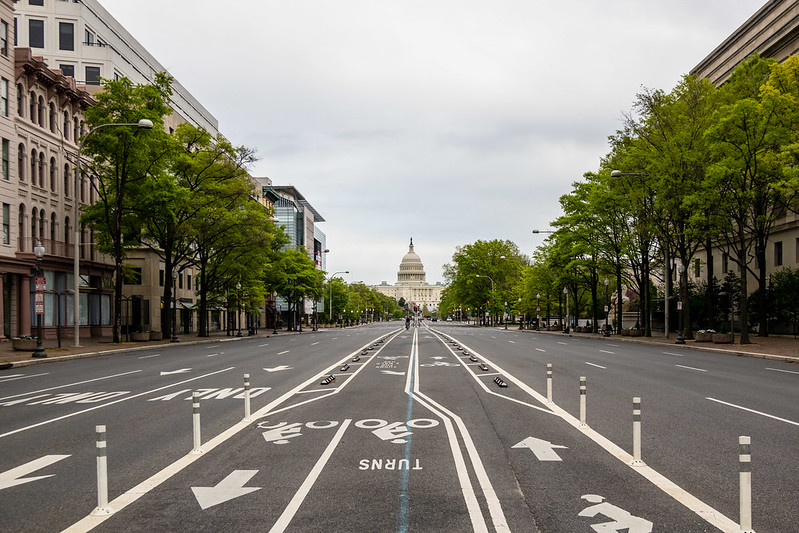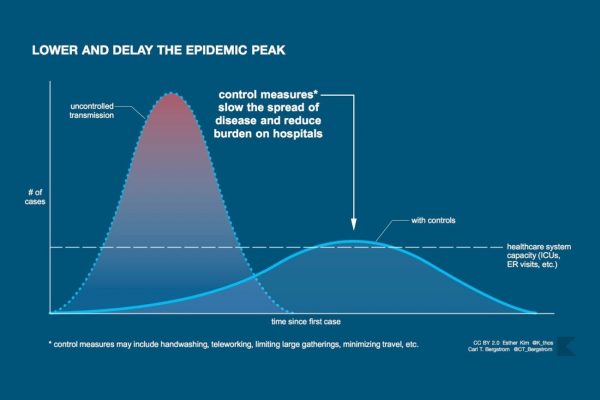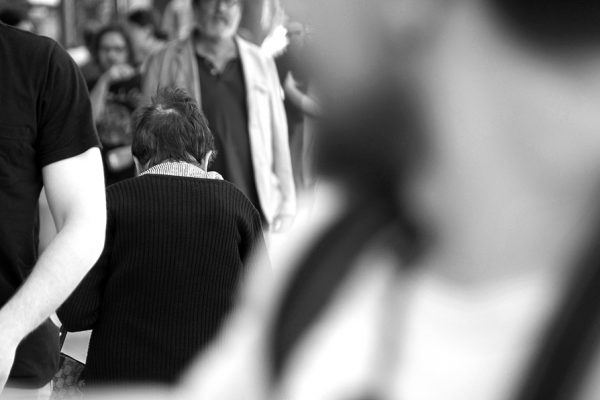A popular Internet meme from recent weeks depicts the following scene in the style of an old tarot card. A screaming woman is being sacrificed to a sullen Sun God, her heart ripped out of her chest and offered to the deity. The labels are brutal: the victim is “Grandma,” the Sun-God is the “Economy,” and the figure who kills Grandma to appease the economic deity is “the Economists” (or Trump, or—in a private version shared in one of my WhatsApp groups—a libertarian friend of mine). (Never mind that professional economists are overwhelmingly in favor of strong measures of social distancing.)
Tradeoffs are inevitable. Trying to quantify the consequences of our choices is our best tool to acquire moral clarity.
Crises encourage simplistic contrasts, and the COVID-19 pandemic—the biggest crisis of our generation—has already spurred many of them. One is precisely the contrast presented in this meme: the survival of those infected with coronavirus versus the survival of our economy. Other extreme contrasts are found in countless op-eds, blog posts, tweets, and private conversations: complete social isolation versus health catastrophe; economic paralysis versus economic normality; civil rights versus death. We are fascinated with simple contrasts, it seems, because they pit some obviously sacred value against a deformed caricature of a conflicting interest: the choice between Grandma and a heartless, impersonal “Economy” is much more resolvable than the real dilemma we face.
Many of these are false dichotomies, fueled by the urgency of the moment. As some observers have acknowledged, between a permanent lockdown and a normal social life, there are arrangements in which our social contacts are temporarily reduced; between halting our economy and sticking to business-as-usual, there are milder combinations of openness and closure, and various forms of government-backed economic support; between renouncing personal freedom and imposing a lethal contagion on friends and strangers, there are reasonable interventions that impose some restrictions on all in order to save the lives of many. And yet, understanding that our choices are more complex than the rhetoric of the simple contrast suggests does not make them easier; if anything, it only makes them harder. The richer our sense of what’s at stake, the more we may be paralyzed by the question of how to act. This problem bottoms out at another, more fundamental contrast between two overriding philosophies of decision-making, each of which has been on wide display as societies around the world grapple with COVID-19.
One approach—call it the “tragic” view—suggests that crucial conflicts have no measurable solution. On this account, we cannot measure and balance matters of life and death, freedom and human dignity: moral questions can’t be solved through a calculation of costs and benefits, and, in a crisis like the present one, there’s a good chance that all our options are morally wrong. The other approach, by contrast, enthusiastically embraces moral measurements; call this the “metric” view. For metricists, even fundamental human values can be measured and compared against one another; in fact, measurement is morally obligatory.
Both the tragic view and the metric view can trick us into a dangerous complacency. Tragic choosers are absorbed in the dilemma itself; metric choosers are absorbed in, and satisfied by, the act of measuring. Both types are at risk of neglecting the hard choices we must make.
Although each approach present risks, I will not make the cheap case for a middle way. I believe that the metricists are right on this essential point: even our fundamental moral and political values can be measured and compared. But metricists often focus on what can be most easily measured and end up neglecting what is most important to measure. The metric view can illuminate our fundamental problem in the present crisis: tradeoffs are inevitable, and trying to measure and quantify the consequences of our choices is our best tool to acquire moral clarity. But the tragic view can remind us that, in a major crisis, all our choices will lead to enormous damage and that some of the things that are the hardest to quantify are in fact among the most important.
Moral Algebra
Thinking about tradeoffs has a long legacy, of course. In a classic expression of this point of view, Benjamin Franklin laid out his personal method for making difficult decisions in a 1772 letter to his English friend Joseph Priestley. Priestley had been offered a job as a librarian by Lord Shelburne; the offer was tempting, but he hesitated because his life was already comfortable and satisfying. Franklin advised him to do some moral algebra to solve the problem:
My Way is, to divide half a Sheet of Paper by a Line into two Columns, writing over the one Pro, and over the other Con. Then during three or four Days Consideration I put down under the different Heads short Hints of the different Motives that at different Times occur to me for or against the Measure. When I have thus got them all together in one View, I endeavour to estimate their respective Weights; and where I find two, one on each side, that seem equal, I strike them both out: If I find a Reason pro equal to some two Reasons con, I strike out the three. If I judge some two Reasons con equal to some three Reasons pro, I strike out the five; and thus proceeding I find at length where the Ballance lies; and if after a Day or two of farther Consideration nothing new that is of Importance occurs on either side, I come to a Determination accordingly.
The procedure is quaintly sensible, if blushingly simplistic. Sure, we cannot really measure whether a certain pro is worth exactly as much as a corresponding con—Franklin concedes this a few paragraphs later in the same letter. But by breaking down and comparing the costs and benefits of the potential situation we gain knowledge, and knowledge is helpful for making decisions.
Many believe that Franklin’s moral algebra—or, rather, a much more sophisticated version of it—is suitable not only for personal decisions, such as that of Joseph Priestly, but also for complex policy choices. The legal scholar Cass Sunstein, for example, celebrates the advances of cost-benefit analysis in his recent book The Cost-Benefit Revolution (2018). Since the administration of Ronald Reagan, Sunstein explains, federal officials acting in an increasing number of fields have been following a simple principle: no action may be taken unless the benefits justify the costs. The principle has been applied to food labeling, bank regulation, car safety, clean air, and various other matters. Applying moral algebra to policy requires a nontrivial leap from the individual to the collective dimension; what counts as a pro for someone might well be a con for someone else. But more data and more facts facilitate the aggregation of conflicting interests and values—an aggregation that democracies must inevitably perform, regardless of the method they adopt to do it—provided that there is clarity and an open conversation on the criteria, beliefs, and values that influence the deliberation.
At the same time, many are skeptical about moral algebra. Some raise concerns because they find the conclusions of cost-benefit analysis counterintuitive. But this is not a good reason for suspicion: challenging our intuitions is the very purpose of the exercise. Others raise more reasonable concerns. How do we measure the non-economic costs of getting sick? How do we measure the psychological fatigue of being isolated at home for months? What if most costs are borne by the poorest and most benefits go to the wealthiest? What if our current preferences, which we use to measure things today, adapt and change tomorrow? What weight, if any, should we give to our strongest convictions, even if they are not justified by the data available at the moment?
These and other important questions are the subject of a large body of research. But the inevitable complications and limitations of a quantitative analysis do not make the analysis unhelpful. Answering some questions is good even if we are left with many unanswered ones, and getting some clarity is good even if many corners remain in shadows.
Understanding that our choices are more complex than the rhetoric of the simple contrast suggests does not make them easier.
When it comes to the most fundamental issues, however, the tragicists object that computations are impossible. Many of us are instinctively repulsed by the use of numbers and weights on matters of life, freedom, and human dignity. Sums and subtractions, many people feel, are the province of accountants and engineers; they are suitable for financial or technical problems, not for moral and political conflicts. There is an invisible boundary, hard to explain but easy to feel, that separates the realm of moral and political questions from the realm of numbers. How can we compare, says the tragicist, the value of human lives with the value of our freedom of movement? Families in Italy are being denied the possibility of a funeral for their loved one: How can we compare, the tragicist insists, this fundamental need with the statistical risk of getting ill?
To make this point, some philosophers appeal to the concept of incommensurability. According to this view, fundamental goods can’t be measured and compared with each other by means of a common unit. Many of these accounts offer insightful analyses of moral reasoning, but they are ultimately unpersuasive in their significance for decision-making. Tradeoffs between moral goods are a fact of life; we can’t trick ourselves into believing otherwise.
Take this example from the legal and political philosopher Joseph Raz’s book The Morality of Freedom (1986). Someone is offered a large sum of money to leave their spouse for a month. Should they accept or refuse the offer? Raz says that the very idea of comparing companionship with money is good reason for indignation: these two values can’t be compared.
But what exactly does this mean? Suppose that such an offer is made. Those who react indignantly will refuse the money and will choose to stay with their spouses. But in doing so, they make a choice and choose one of the two options (companionship) over the other (money). For all practical purposes, they compare those two values and regard one as superior to the other. Moreover, we can easily conceive of a sufficiently large amount of money that might tilt the scale in the other direction: say, so much money to allow the couple to help the lives of friends in need. In the end, then, it seems the two values are, in fact, commensurable.
Consider another example from Elizabeth Anderson’s essay “Practical Reason and Incommensurable Goods” (1997). Suppose someone can save her mother’s life by giving up a friendship. Anderson argues that those values are incommensurable. Yet still she thinks that the obligations toward our mothers and the obligations toward our friends are different, and we can make a rational choice based on this fact. For all practical purposes, then, we can choose one option over the other.
The point is that reality itself obliges us to trade off crucial values: we can’t escape having to choose. If we must choose, we must compare; and if we must compare, we must measure, however crudely or imperfectly. Some philosophers would object that comparison does not necessarily require measurement; indeed, the wide literature on this subject distinguishes between incomparability and incommensurability. But regardless of the method we use to choose and the label we attach to such method, when we compare two options and conclude that one is preferable to the other, we are ultimately making some kind of measurement, even if only implicitly or unwittingly.
For metricists, the least horrible option is also the morally right one, even though it may produce great (sometimes irreparable) pain.
If, for example, we choose to refuse $1,000 for leaving our spouse for one month, but we would not refuse $1,000,000, we are measuring one month of companionship in monetary terms—in fact, as brutal as it may sound, we are pricing it somewhere between $1,000 and $1,000,000. If, for another example, we conclude that our obligation to save our mother’s life takes precedence over our obligation to stay in touch with a good friend but yields, say, to our obligation not to commit a serious crime, we are ranking these obligations—a process sometimes called an “ordinal measurement.” Even if we believe that our options have different kinds of value, the fact that we can still rank or weigh them means that there is some standard by which we do the ranking and weighing. We can debate the conceptual characterization and the many analytical distinctions of each scenario, but the crucial part of our task remains the same: we must rank, balance, and weigh life, health, freedom, mourning, and economic security.
Even a narrow conception of incommensurability—one that admits of comparison between crucial values, although not necessarily by some numerically precise scale of units—might obscure important practical aspects of hard choices. When we focus too much on incommensurability, we become at risk of educating citizens and decision-makers to be unduly skeptical of some of our most powerful tools: data, quantitative models, estimates. Most importantly, we become at risk of indulging our instinctive but deceptive rejection of moral tradeoffs.
Metricists appreciate this point. They feel the inevitability of tradeoffs and the need to measure and compare to improve moral clarity. Some of them have no spontaneous repulsion for the contamination between numbers and morality; others instead have made a successful effort to overcome that repulsion for the sake of the common good. They believe that ethics is all about making the best choice among the available options, however horrible they happen to be. For metricists, the least horrible option is also the morally right one, even though it may produce great (sometimes irreparable) pain.
I think the metricists are right on this point: moral algebra is inevitable and helpful. First of all, it is helpful as a prerequisite of deliberation. How could we possibly compare our moral and political options without detailed data on the lethality of the virus; age distribution of infections, hospitalizations, and deaths; effects of social distancing on unemployment and the supply chain; and many other crucial facts of the pandemic? Second, it is helpful as a way to make sense of the data. How could we possibly deliberate without trying to measure the damages that our lives, health, sanity, social relationships, and political communities may suffer as a result of this or that decision? Even imprecise numbers are sometimes useful: they force us to think about how changes in circumstances, beliefs, and values should change our conclusions. Although those numbers are not accurate and should not be trusted to make close judgment calls, the very act of confronting them teaches us something about value relations—that is, about how the choices we are facing are influenced by data and their fluctuation.
The Blind Spots of Measurement
Where, then, do the metricists falter? When they fall in love with problems rather than with solutions, process at the expense of outcome. In fact, the problem plagues both moral camps: tragicists sometimes remain excessively fascinated with dilemmas, metricists with measurements and models. After they reach a sufficient level of complexity, problems become akin to games: they have their own rules, their own grammar and style, and their own beauty. But too often metricists get trapped in numerical games and forget the ultimate goal: making the right choice.
Metricists falter when they fall in love with problems rather than solutions. Too often they get trapped in numerical games.
One way that measurement can distort the choice is by virtue of an excessive focus on what is easily measurable instead of what ought to be measured. Many graphs, for example, try to tell us how the case fatality risk for COVID-19 varies by age group. This is very important because by knowing how the virus affects young and old differently, we can devise a strategy with different solutions for people of different ages. No model, however, tries to calculate the damage of postponing or canceling elections or the damage of becoming accustomed to intrusive state surveillance. Why? Because these effects are extremely hard to measure. Metricists focus their efforts on the narrow tasks in which they are more likely to succeed, and among the most measurable things, metricists tend to focus on those that can be measured more accurately or more elegantly. But what is more easily measured and more robustly modeled is not necessarily what is important.
One crucial aspect of social life that is extremely hard to quantify is what we might call anti-aspiration. The philosopher Agnes Callard, in her book Aspiration (2018), argues that when our values change, we become, in some important way, a different person. Before becoming parents, for example, we might consider being a parent as a boring and unpleasant condition; after becoming one, however, we might well like it. In that case, our values and preferences will have changed. Callard proposes that the act of transforming ourselves from the old version to the new version is not easily understood as a “decision.” It is rather a long “transformative journey,” which Callard calls “aspiration” and which is dependent on culture and social environment: it often starts before the aspirant has any relation at all with the new value she will come to care about.
Callard’s theory is about who we aspire to become. But the opposite journey is possible as well; we can embark on a process that transforms us into a person we would rather not be. This anti-aspiration is extremely hard to measure and model: right now we are not that kind of person and do not want to be, but if we do become that person, we will have values that justify our being that way.
The present crisis, like any major crisis, can trigger a collective anti-aspirational process. We might estimate, for example, that the risk of a large number of deaths is morally acceptable in order to avoid serious harm to the material and psychological well-being of survivors. However, if we proceed down that path, we might well discover, in a few years, to have become the kind of community that lacks the values and character that made that well-being possible in the first place. This is, of course, a mere conjecture, but it is the kind of conjecture that metricists are not inclined to explore. Yet our collective choices today contribute to the cultural and moral environment that will shape our collective choices tomorrow. We must consider these indirect consequences in our deliberation, even it is extremely hard to quantify them.
The tragic view, or at least a tragic sentiment, can serve as a precious and essential antidote to metricist hubris.
The most visible face of measurement is the mathematical model and its output: the quantification that puts a neat number on what we are trying to figure out. But that number is driven by many complex assumptions and value judgments, which often receive inadequate scrutiny not only by the general public but sometimes also by the experts in the field. Since assumptions and simplifications are inevitable, their flaws are more easily tolerated than are flaws in the mathematical process. Sometimes, however, unrealistic or extremely narrow assumptions are far more problematic, in terms of moral and policy significance, than computation glitches. Metricists, by contrast, are often trained to value the technical machinery more than the substantive relevance of its applications.
All these blind spots must be taken seriously, and they limit what metricism has to offer. Moreover, numerical models and estimates may create a false sense of confidence. We must compare and measure, but we cannot afford the seduction of simple and elegant measurement. The tragic view, or at least a tragic sentiment, can serve as a precious and essential antidote to metricist hubris.
A Sense of the Tragic
In a paper on the moral limits of cost-benefit analysis, the philosopher Martha Nussbaum once argued that in any critical decision we have to answer an obvious question, which is the question of what we ought to do, as well as a tragic question, which is whether any of our options is morally acceptable. The contention of the metricists is that the question of what we ought to do is the question of what the morally acceptable choice is. I think they are right, but I also think we must also cultivate a sense of the tragic: an awareness that, in the most critical times, the morally right choice might not be devoid of harm or, in the worst case, outright evil.
In Aeschylus’s Agamemnon, the chorus tells the horrible story of the sacrifice of Iphigenia. The Greek fleet, ready to sail for Troy, is stuck in the port because there is no wind. The prophet Calchas knows what the problem is: the goddess Artemis is angry and has stopped the winds from blowing. If the Greeks leave the port, they will eventually win the war and conquer Troy. But for that to happen, their commander-in-chief Agamemnon must sacrifice his daughter Iphigenia. Agamemnon has a horrific choice to make: lose the war or kill his daughter. In the translation by Anne Carson, this is how the King of Argos ponders the decision:
Hard for me to disobey.
Hard for me to cut down my own daughter,
prize of my house,
defiling a father’s hand with a girl’s blood at the altar.
Which of these is apart from evil?
Agamemnon will sacrifice his daughter: that option will seem to him the right one to choose, although not one without evil. The Greeks will win the war, but the life of Agamemnon and of his family will be ruined. “Do you think the gods ignore a man who steps on holy things?” the chorus asks, knowing the answer.
But if Agamemnon made the right choice, why does he get punished? If moral measurement tells us what the preferable option is, what’s wrong with choosing it? In a beautiful passage from The Fragility of Goodness (1986), Nussbaum says that Agamemnon’s sin is embracing his terrible choice optimistically and even enthusiastically. “May all turn out well,” he says. Agamemnon’s guilt is not that he chose the wrong option, but that he did not struggle against it. It is not a matter of action but a matter of passion.
Unlike Aeschylus’s tragic hero, we can (and must) trust our ability to balance and reconcile what appear as irreconcilable duties.
We are not in the hands of capricious gods anymore. Although we struggle with forces that we are not always able to understand or control, we have developed powerful tools to deal with our fallibility: rationality, science, public debate, democracy. We must demand that our governments use these tools to confront this crisis: by being truthful to the public, by producing and using accurate data, by funding and promoting scientific and technological research without obtuse bureaucracies or political opportunism, by creating sensible paths that avoid the false dichotomies of demagogues, and by comparing and weighing painful choices without fear of contamination between moral values and numbers. Unlike Aeschylus’s tragic hero, we can (and must) trust our rational ability, as individuals and as a society, to balance and reconcile what appear as irreconcilable duties.
At the same time, we must demand that our leaders understand their tragic role. They should push experts to estimate and measure the things that are hardest to measure. They should insist on an honest and full accounting of blind spots, uncertainties, and limitations. They should subject their analysis to transparent democratic scrutiny. They should question the hubris and false confidence of the most elegant models. And they must always be aware that, in the end, any critical choice will be based on some conjectures about the kind of society we aspire to be. We can’t just wish that all will turn out well. We must recognize that the right thing to do, whatever we collectively decide it to be, may require us to step on holy things—and this will get us punished, even if we are in the right.









